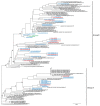Phylogenetic Analysis of MERS-CoV in a Camel Abattoir, Saudi Arabia, 2016-2018
- PMID: 33219804
- PMCID: PMC7706958
- DOI: 10.3201/eid2612.191094
Phylogenetic Analysis of MERS-CoV in a Camel Abattoir, Saudi Arabia, 2016-2018
Abstract
We detected Middle East respiratory syndrome coronavirus (MERS-CoV) RNA in 305/1,131 (27%) camels tested at an abattoir in Al Hasa, Eastern Province, Saudi Arabia, during January 2016-March 2018. We characterized 48 full-length MERS-CoV genomes and noted the viruses clustered in MERS-CoV lineage 5 clade B.
Keywords: MERS; MERS-CoV; Middle East respiratory syndrome; Saudi Arabia; abattoir; camels; coronavirus; dromedary; phylogeny; respiratory infections; viruses; zoonoses.
Figures

Similar articles
-
Cross-sectional study of MERS-CoV-specific RNA and antibodies in animals that have had contact with MERS patients in Saudi Arabia.J Infect Public Health. 2018 May-Jun;11(3):331-338. doi: 10.1016/j.jiph.2017.09.022. Epub 2017 Oct 6. J Infect Public Health. 2018. PMID: 28993171 Free PMC article.
-
Genomic Sequencing and Analysis of Eight Camel-Derived Middle East Respiratory Syndrome Coronavirus (MERS-CoV) Isolates in Saudi Arabia.Viruses. 2020 Jun 3;12(6):611. doi: 10.3390/v12060611. Viruses. 2020. PMID: 32503352 Free PMC article.
-
Longitudinal study of Middle East Respiratory Syndrome coronavirus infection in dromedary camel herds in Saudi Arabia, 2014-2015.Emerg Microbes Infect. 2017 Jun 21;6(6):e56. doi: 10.1038/emi.2017.44. Emerg Microbes Infect. 2017. PMID: 28634355 Free PMC article.
-
Middle East Respiratory Syndrome Coronavirus (MERS-CoV) origin and animal reservoir.Virol J. 2016 Jun 3;13:87. doi: 10.1186/s12985-016-0544-0. Virol J. 2016. PMID: 27255185 Free PMC article. Review.
-
Middle East respiratory syndrome coronavirus (MERS-CoV): animal to human interaction.Pathog Glob Health. 2015;109(8):354-62. doi: 10.1080/20477724.2015.1122852. Pathog Glob Health. 2015. PMID: 26924345 Free PMC article. Review.
Cited by
-
MERS-CoV Found in Hyalomma dromedarii Ticks Attached to Dromedary Camels at a Livestock Market, United Arab Emirates, 2019.Viruses. 2023 May 30;15(6):1288. doi: 10.3390/v15061288. Viruses. 2023. PMID: 37376588 Free PMC article.
-
Exploring the potential roles of some rodents in the transmission of the Middle East respiratory syndrome coronavirus.J Med Virol. 2021 Sep;93(9):5328-5332. doi: 10.1002/jmv.27023. Epub 2021 May 3. J Med Virol. 2021. PMID: 33851740 Free PMC article.
-
Scanning Electron Microscopic Findings on Respiratory Organs of Some Naturally Infected Dromedary Camels with the Lineage-B of the Middle East Respiratory Syndrome Coronavirus (MERS-CoV) in Saudi Arabia-2018.Pathogens. 2021 Apr 1;10(4):420. doi: 10.3390/pathogens10040420. Pathogens. 2021. PMID: 33916036 Free PMC article.
-
Functional comparison of MERS-coronavirus lineages reveals increased replicative fitness of the recombinant lineage 5.Nat Commun. 2021 Sep 7;12(1):5324. doi: 10.1038/s41467-021-25519-1. Nat Commun. 2021. PMID: 34493730 Free PMC article.
-
Modelling transmission of Middle East respiratory syndrome coronavirus in camel populations and the potential impact of animal vaccination.Nat Commun. 2025 Aug 18;16(1):7679. doi: 10.1038/s41467-025-62365-x. Nat Commun. 2025. PMID: 40825940 Free PMC article.
References
-
- World Health Organization. WHO MERS global summary and assessment of risk, July 2019. [cited 2020 Jan 21]. https://apps.who.int/iris/bitstream/handle/10665/326126/WHO-MERS-RA-19.1...
MeSH terms
Substances
LinkOut - more resources
Full Text Sources

